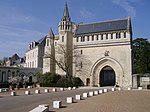Tours Speedway
2012 establishments in FranceDefunct motorsport venues in FranceNASCAR tracksSport in Tours, FranceSports venues in Indre-et-Loire

Tours Speedway is an oval speedway located in Tours, France. The track is located at the parkingplace of the Parc des expositions east of the city. It was first used in 2012. The only event raced on the track is the NASCAR Whelen Euro Series. On October, 2nd, Tours announced that the 2018 NASCAR Whelen Euro Series race will be the last NASCAR race in this track.
Excerpt from the Wikipedia article Tours Speedway (License: CC BY-SA 3.0, Authors, Images).Tours Speedway
Avenue Camille Chautemps, Tours Rochepinard
Geographical coordinates (GPS) Address Nearby Places Show on map
Geographical coordinates (GPS)
| Latitude | Longitude |
|---|---|
| N 47.3782 ° | E 0.7247 ° |
Address
Avenue Camille Chautemps
37550 Tours, Rochepinard
Centre-Val de Loire, France
Open on Google Maps










